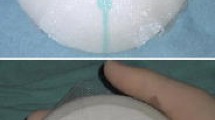Abstract
Background
Numerous techniques for mastopexy and breast reduction have been described, indicating the absence of a generally accepted method that fulfills the essential criteria for obtaining a pleasing, long-lasting result. All techniques using local tissue for reinforcement will eventually face recurrent ptosis because essentially the physical tissue properties are not altered. To overcome this, synthetic mesh has successfully been used to obtain permanent results. This method, however, was not generally accepted because of the fear of complications and of reduced oncologic survey and because no practical system was in place. Meanwhile, research showed that mesh could be safely introduced into the female breast.
Methods
An easy-to-use mesh implant was developed. It comes as a system consisting of three-dimensional, preshaped, feather-soft woven mesh in different sizes, and concomitant sizers to facilitate the insertion. It acts as an internal bra and is therefore named “the Internal Bra System.” The mesh replaces the attenuated natural suspensory system of the breast, returning what was lost by nature. Indications are breast ptosis, breast hypertrophy with ptosis, and contralateral correction after reconstruction.
Results
A total of 170 patients (327 breasts) were treated with the longest follow-up of 4.5 years. No serious complications were encountered. Physical and X-ray examinations were still possible. No recurrent ptosis was observed and no scar hypertrophy.
Conclusion
The Internal Bra System seems to have finally become the versatile way to obtain a predictable, pleasing, long-term result in mastopexy and breast reduction.














Similar content being viewed by others
References
de Araujo Cerqueira A (1998) Mammoplasty: breast fixation with dermoglandular mono upper pedicle flap under the pectoralis muscle. Aesthetic Plast Surg 22:276–83
Flowers RS, Smith EM (1998) “Flip-flap” mastopexy. Aesthetic Plast Surg 22:425–429
Grotting JC, Chen SM (2005) Control and precision in mastopexy. In: Nahai F (ed) Aesthetic surgery. Quality Medical Publishing, St. Louis, pp 1908–1950
Gruber RP, Jones HW (1980) The “donut” mastopexy: indications and complications. Plast Reconstr Surg 65:34–8
Nahai F (2005) Control and precision in mastopexy. In: Nahai F (ed) Aesthetic surgery. Quality Medical Publishing, St. Louis, pp 1818–1858
Qiao Q, Sun J, Liu C, Liu Z, Zhao R (2003) Reduction mammaplasty and correction of ptosis: dermal bra technique. Plast Reconstr Surg 111:1122–1130
Ritz M, Silfen R, Southwick G (2006) Fascial suspension mastopexy. Plast Reconstr Surg 117:86–94
Goés JCS, Landecker A, Lyra EC, Henriquez LJ, Goés RS, Godoy PM (2004) The application of mesh support in periareolar breast surgery: clinical and mammographic evaluation. Aesthetic Plast Surg 28:268–274
Bartels RJ, Strickland DM, Douglas WM (1976) A new mastopexy operation for mild or moderate ptosis. Plast Reconstr Surg 57:687
Baumeister RG (2003) Curtain type combined pedicled reduction mammoplasty with internal suspension for extensive hypertrophic and ptotic breasts. Br J Plast Surg 56:114–119
Benelli L (1990) A new periareolar mammaplasty: the “round block” technique. Aesthetic Plast Surg 14:93–100
de Benito J, Sanza IF (1993) Periareolar techniques for mammary reduction and elevation. Aesthetic Plast Surg 17:311–316
Caldeira AM, Lucas A (2000) Pectoralis major muscle flap: a new support approach to mammaplasty, personal technique. Aesthetic Plast Surg 24:58–70
Da Silva G (1964) Mastopexy with dermal ribbon for supporting the breast and keeping it in shape. Plast Recontr Surg 34:403–405
Erol OO, Spira MA (1980) Mastopexy technique for mild to moderate ptosis. Plast Reconstr Surg 65:603–609
Fayman MS (1998) Short scar mastopexy with flap transposition. Aesthetic Plast Surg 22:135–141
Frey MA (1999) New technique of reduction mammaplasty: dermis suspension and elimination of medial scars. Br J Plast Surg 52:45–51
Goés JCS (2006) Periareolar mammoplasty: double-skin technique with application of mesh support. In: Spear SL (ed) Sugery of the breast. Lippincott Williams & Wilkins, Philadephia, pp 991–1007
Graf R, Reis de Araujo LR, Rippel R, Neto LG, Pace DT, Biggs T (2003) Reduction mammaplasty and mastopexy using the vertical scar and thoracic wall flap technique. Aesthetic Plast Surg 27:6–12
Hanrahan EM (1950) Mammaplasty: one-stage transposition operation. Plast Reconstr Surg 6:110–118
Hinderer UT (1976) The dermal brassiere mammaplasty. Clin Plast Surg 3:349–70
Hinderer UT (2001) Circumareolar dermo-glandular plication: a new concept for correction of breast ptosis. Aesthetic Plast Surg 25:404–420
Lalardrie JP (1983) Reduction mammoplasty: the “dermal vault” technique. In: Georgiade NG (ed) Aesthetic Breast Surgery. Williams & Wilkins, Baltimore, pp 166–174
Levet Y (1993) Le pedicule posterior: un concept anatomochirurgical de plastie mammaire. Ann Chir Plast Esthet 38:463–468
Lewis GK (1956) A method of mastopexy with fascia lata transplants. J Int Coll Surg 26:346–353
Lockwood T (1999) Reduction mammaplasty and mastopexy with superficial fascial system suspension. Plast Reconstr Surg 103:1411–1420
Marchac D, de Olarte G (1982) Reduction mammaplasty and correction of ptosis with a short inframammary scar. Plast Reconstr Surg 69:45–55
Marconi F (1989) The dermal pursestring suture: a new technique for a short inframammary scar in reduction mammaplasty and dermal mastopexy. Ann Plast Surg 22:484–493
Perez-Macias JM (2007) Long-lasting evolution of ptosis control after reduction mammaplasty using the hammock technique. Aesthetic Plast Surg 31:266–74
De la Plaza R, de la Cruz L, Moreno C, Soto L (2004) The crossed termal flaps technique for breast reduction. Aesthetic Plast Surg 28:383–392
Ribeiro L (1975) A new technique for reduction mammaplasty. Plast Reconstr Surg 55:330–334
Spear SL, Giese SY, Ducic I (2001) Concentric mastopexy revisited. Plast Reconstr Surg 107:1294–1299
Spear SL, Kassan M, Little JW (1990) Guidelines in concentric mastopexy. Plast Reconstr Surg 85:961–966
Svedman P (1991) Correction of breast ptosis utilizing a “fold over” deepithelialized lower thoracic fasciocutaneous flap. Aesthetic Plast Surg 15:43–47
Widgerow AD (2005) Breast reduction with inferior pedicle fascial suspension. Aesthetic Plast Surg 29:532–537
Bustos RA (1992) Periareolar mammaplasty with silicone supporting lamina. Plast Reconstr Surg 89:646–657
Dessapt B(1994) Internal breast support grids in the surgery for breast hypertrophy and ptosis. Technique and indications. Ann Chir Plast Esthet 38:313–322
Auclair E, Mitz V (1993) Repair of mammary ptosis by insertion of an internal absorbable support and periareolar scar. Ann Chir Plast Esthet 38:107–113
Johnson GW (1981) Central core reduction mammaplasties and and Marlex suspension of breast tissue. Aesthetic Plast Surg 5:77–84
Goés JCS (1992) Periareolar mammplasty: double-skin technique with application of Polyglactine 910 mesh. Rev Soc Bras Cir Plast 7:1–3
Góes JCS (1996) Periareolar mammaplasty: double skin technique with application of polyglactine or mixed mesh. Plast Reconstr Surg 97:959–968
Góes JCS (1998) Periareolar mastopexy and reduction with mesh support. Breast Surg 51:697–708
Góes JCS (2003) Periareolar mastopexy: double skin technique with mesh support. Aesthetic Surg J 3:129–135
Sun JM, Qiao Q, Liu ZF, Zhao R (2003) Breast ptosis correction with a knitted polypropylene mesh. Zhonghua Zheng Xing Wai Ke Za Zhi 19:27–29
Lejour M (1994) Vertical mammaplasty and liposuction of the breast. Plast Reconstr Surg 94:100–104
Wise RJ (1956) A preliminary report on a method of planning the mammaplasty. Plast Reconstr Surg 17:367–375
Cooper AP (1840) On the anatomy of the breast. Longmans, London
Wueringer E, Tschabitscher M (2002) New aspects of the topographical anatomy of the mammary gland regarding its neurovascular supply along a regular ligamentous suspension. Eur J Morphol 40:181–189
Schumpelick V, Klinge U, Junge K, Stumpf M (2004) Incisional abdominal hernia: the open mesh repair. Langenbecks Arch Surg 389:1–5
Graf R, Biggs TM (2002) In search of better shape in mastopexy and reduction mammaplasty. Plast Reconstr Surg 110:309–317
Cobb WS, Kercher KW, Heniford BT (2005) The argument for lightweight polypropylene mesh in hernia repair. Surg Innov 12:63–69
Tristant H, Hazebroucq V, Benmussa M, Bokobsa J, Elbaz P (1997) Internal supporting mammary lamina. Results of the detection of breast lesions. Ann Chir Plast Esthet 42:183–91
Celebiler O, Sönmez A, Erdim M, Yaman M, Numanoğlu A (2005) Patients’ and surgeons’ perspectives on the scar components after inferior pedicle breast reduction surgery. Plast Reconstr Surg 116:459–64
Niessen FB, Spauwen PH, Robinson PH, Fidler V, Kon M (1998) The use of silicone occlusive sheeting (Sil-K) and silicone occlusive gel (Epiderm) in the prevention of hypertrophic scar formation. Plast Reconstr Surg 102:1962–1972
Gonzalez R, Ramshaw BJ (2003) Comparison of tissue integration between polyester and polypropylene prostheses in the preperitoneal space. Am Surg 69:471–476
Klosterhalfen B, Klinge U, Schumpelick V, Tietze L (2000) Polmers in hernia repair—common polyester vs. polypropylene surgical meshes. J Mater Sci 35:4769–4776
Klosterhalfen B, Junge K, Klinge U (2005) The lightweight and large porous mesh concept for hernia repair. Expert Rev Med Devices 2:103–117
Acknowledgments
The authors thank Professor Stan Monstrey, MD, PhD, plastic surgeon, University of Gent, Belgium, for his critical review of the manuscript. They also thank Dr. A.M. Krukkert, MD, pathologist, Regional Laboratory of Pathology, Enschede, Netherlands, for her histologic examinations.
Author information
Authors and Affiliations
Corresponding author
Additional information
The authors have no financial interest or commercial association with any of the mesh manufacturers. However, they have an interest in the Breform company that developed the intellectual property.
Rights and permissions
About this article
Cite this article
de Bruijn, H.P., Johannes, S. Mastopexy with 3D Preshaped Mesh for Long-Term Results: Development of the Internal Bra System. Aesth Plast Surg 32, 757–765 (2008). https://doi.org/10.1007/s00266-008-9186-y
Received:
Accepted:
Published:
Issue Date:
DOI: https://doi.org/10.1007/s00266-008-9186-y




